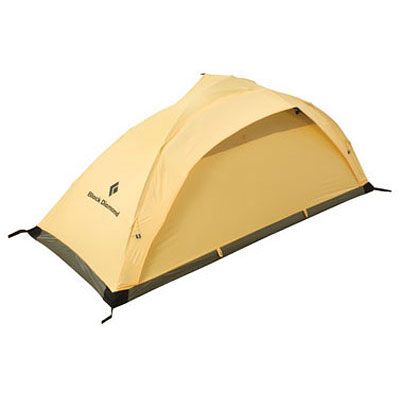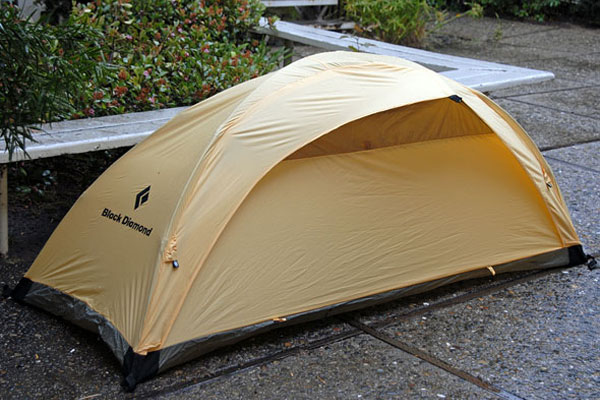Black Diamond Oneshot

- freestanding solo tent
- single-wall
- enhanced ventilation
- 2lbs 6.5oz
Black Diamond's solo Oneshot is an intriguing addition to the company's ultralight tent lineup. Like the Firstlight, the OneShot is a freestanding, single-wall shelter made from Epic fabric.
Unlike the bare-bones Firstlight, however, the OneShot is a refined tent with a host of clever features. Black Diamond has moved the door to the OneShot's side, and added a zipper mesh window/vent to the opposite side of the tent, creating a potent (and customizable) venting system. This is made possible by the big design change—a cross-pole at the tent's apex, which creates twin awnings.

While these awnings are relatively small, they allow the tent's door and vent window to remain open even in the rain—and make it easier to get in and out without soaking the tent's interior. The awnings allow a modest view when you're tent-bound. The view is limited by the OneShot's narrow profile, but far better than just staring at blank yellow walls.
Another benefit of the cross-pole, according to Black Diamond, is enhanced structural strength. The design helps prevent the sides of the OneShot from billowing inward in the wind. I rode out a night of 40-50 mph winds in the OneShot. Because the tent is so narrow, you will notice the sides as they move with the wind. However, the tent's stability, overall, seemed quite good.
Clearly, the cross-pole awning design does enhance stability. I do wonder, however, how much this benefit is compromised by the resulting increase in drag (the awnings can act as natural wind traps). On the subject of storm-worthiness, no discussion of Epic tents is complete without noting the fabric's ambiguous 'highly water-resistant' rating.
If you're stuck in the middle of nowhere in the rain, you don't want that to be the time you learn that water-resistant doesn't mean waterproof. How waterproof is Epic? There doesn't seem to be a definitive answer. Reports abound of Epic performing like a star in overnight downpours, especially in arid climates. An Epic fabric tent should be perfectly fine for weathering summer thunderstorms in the mountains or deserts.
In areas of high humidity, however, or any trip where sustained, multi-day downpours are a possibility, an Epic tent seems like a less than ideal choice to me—if only for peace of mind. On the positive side, thanks to its single-wall design, the OneShot is a drastically light shelter, weighing barely 2 pounds six ounces (tent and poles only). Note that this is not a large reduction compared to the 2-man Firstlight's base weight: a direct consequence of the new three-pole design.
Finally, it is perhaps not reasonable to expect a solo tent to have a roomy interior. Even so, the OneShot is a small tent that will not likely fit climbers over 6' tall. The front and back walls angle steeply; expect your head and feet to be in some contact with fabric.
In terms of design, I can't help thinking the OneShot is clearly better than the Firstlight—and yet, the Firstlight may well be the better solo tent. For an extra four ounces or so, the Firstlight nearly doubles the OneShot's interior volume. Both shelters are similar enough otherwise to raise a interesting question: do you really want to give up that much room to save four or five ounces?






 Big Agnes Fly Creek Platinum 1
Big Agnes Fly Creek Platinum 1 Mountain Hardwear Optic
Mountain Hardwear Optic Mountain Hardwear Skyledge
Mountain Hardwear Skyledge Black Diamond Hilight
Black Diamond Hilight